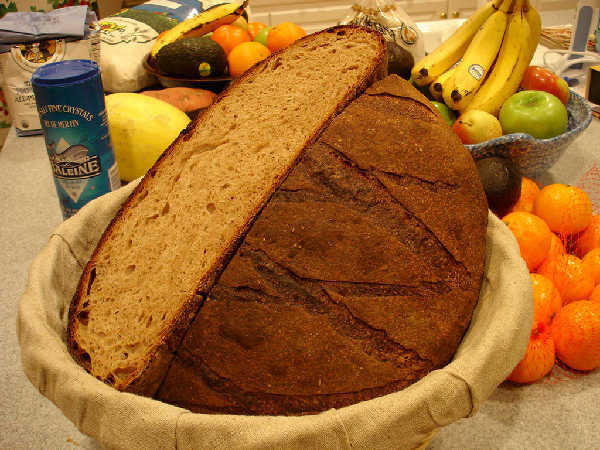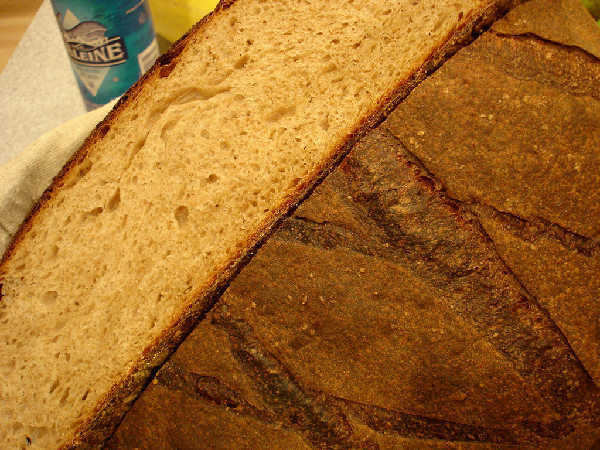

Zolablue, a frequent TFL contributor, encouraged me to try the Thom Leonard Country French recipe in Artisan Baking by Glezer. This recipe is a variation that incorporates some of the things I have liked in other miche recipes. For example, I am using Heartland Mills Golden Buffalo flour as the main flour, but spelt and rye are added in the levain, and there is some additional whole wheat added with a soaker. The hydration is lower than most of the other miche recipes I've tried or blogged here on TFL, which gives it a slightly more regular, dense crumb that is excellent for sandwiches or for holding honey or any wetter toppings. It is a robust texture, as opposed to a very light, irregular, open structure.
Spreadsheets in xls and html format are posted with weights in ounces, bakers percentages, and other possibly useful information. Some photos of the process are posted, as well.
Levain:
- 10g white flour paste consistency starter (I used my 90% hydration white flour starter) Use about 8 grams of 60% hydration firm starter.
- 58g whole rye flour
- 119g whole spelt flour
- 141g water
Soaker:
- 203g whole wheat flour (I used Wheat MT Bronze Chief)
- 203g water
Dough:
- 1 tsp diastatic malted barley powder
- 15g malt syrup
- 27g salt
- 721g water
- 203g AP flour (I used KA Organic AP)
- 763g high extraction flour (I used Heartland Mills Golden Buffalo)
The dough was initially mixed/kneaded in a DLX mixer on low/medium speed for about 8 minutes. It was allowed to rest in the mixing bowl for about 1/2 hour and then kneaded in the mixer for another 5 minutes. The dough was dropped on the counter and folded into a ball and placed in a rising bucket. It was placed in a warm area, about 76F, for the bulk fermentation, which should run about 4.25 hours at 75F. The bulk fermentation should take about 6 hours at 70F or 8.5 hours at 65F.
Folding
The dough is fairly firm with the very water absorpent Heartland Mills Golden Buffalo and whole rye at a 79% hydration. At this consistency, the dough is stiff enough that it resists much folding, so it was folded only once about 1.5 hours before shaping.
Shaping and Final Proof
A boule was formed and allowed to sit on the counter for 10 minutes to seal the seams. Note, the loaf doesn't rise by double during bulk fermentation. The loaf was placed upside down in a lined round wicker basket style banneton dusted with a mixture of semolina, rice, and bread flour. The loaf was also dusted with the dusting mixture plus a small amount of bran. The basket and a bowl of warm water was placed in a Ziploc "Big Bag" and allowed to rise for 3.5 hours at 75F. Allow 4.5 hours at 70F for the final proof or 6.5 hours at 65F.
Peeling and Scoring
The boule was turned out on a piece of semolina and corn meal dusted parchment paper on a large peel and slashed with a cross-hatch pattern.
Bake
This loaf was baked in a brick oven after some focaccias were baked, as noted in another blog entry recently. The hearth temperature had dropped to about 485F, and the air temperature was about 425F. The oven was steamed using a very fine garden sprayer designed for orchids (1/6 gal/minute, by Foggit) and sealed with a towel covered wooden door for 15 minutes. It was then rotated and sealed with a metal door thereafter for a total bake time of about 1 hour. The hearth temperature dropped to about 445F at the end of the bake.
To do the same thing in the kitchen oven, I would use a stone and preheat the oven to 500F and steamed according to your favorite method. I use a cast iron skillet and place a special can with a small hole drilled in it with about 1 cup of water that dribbles out creating steam in the oven for about 10 minutes. I drop the oven temperature to 450F for the first 15 minutes, immediately after adding the water, and then drop the temperature to about 400F or lower, for the rest of the bake, monitoring the crust color and dropping the temperature further to avoid charred crust.
Cool
Allow to fully cool on a rack before cutting.
Results
This is a great loaf for any juicy ingredients, or things like honey, mayo, and whatnot. It's more dense and chewy than other miches I've blogged on TFL. It has a nutty, toasty, and slightly sweet flavor, I believe due to the spelt, and is a little crunchy due to the crisp thick crust that has a little bran encrusted in it, and maybe also from the added whole wheat.
No comments:
Post a Comment
Note: Only a member of this blog may post a comment.